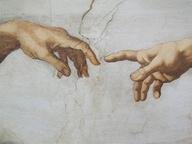Quiz Answer Key and Fun Facts
1. How much time had elapsed between the completion of the ceiling and the painting of the "Last Judgement"?
2. Prior to the beginning of work on the frescoes, the wall had been prepared for painting to be done in oils.
3. Michelangelo used the same color palette for the "Last Judgement" as for the Sistine ceiling.
4. Which of the following is NOT true of the angels as depicted in the "Last Judgement"?
5. What objects are borne aloft by the angels in the lunettes at the top of the mural?
6. Which of these apostles is NOT depicted in the "Last Judgement"?
7. Apart from Mary, which of these relatives of Christ is shown in the "Last Judgement"?
8. Apart from Mary, who is the only identifiable female saint? (she holds a piece of a broken wheel)
9. On the lower right, a figure being dragged down by demons holds a hand over one eye while the other stares in terror at the viewer. What surprising fact about this figure emerged during the recent cleaning?
10. Which best describes the expressions of the dead being raised to life in the lower left of the painting?
11. On the lower left, some dark-skinned figures are being pulled upward by an angel using what implements?
12. Which figures from pagan mythology appear in this mural?
13. Which figure is a caricature of Michelangelo's chief nemesis, papal nuncio Biagio da Cesena?
14. Michelangelo had also been commissioned to paint a fresco on the opposite (entrance) wall of the Sistine chapel.
15. The figures of two of the martyr-saints on the right hand side of the mural were repainted almost completely many years after the work's completion.
16. There is considerable damage to a middle section of the painting, depicting angels sounding the last trumpets. What caused this damage?
17. Michelangelo depicts Christ as young, ruggedly muscular, thick-waisted and beardless.
18. What very unusual object can be seen in the water in front of the boat on which the damned are being herded across the river Styx?
19. Which figure from the Sistine ceiling mural is directly above the "Last Judgement"?
20. Having painted the ceiling of the Sistine chapel, Michelangelo did not wish to do any more painting there, but he was forced to begin work on the "Last Judgement" by order of this pope.
Source: Author
jouen58
This quiz was reviewed by FunTrivia editor
thejazzkickazz before going online.
Any errors found in FunTrivia content are routinely corrected through our feedback system.
